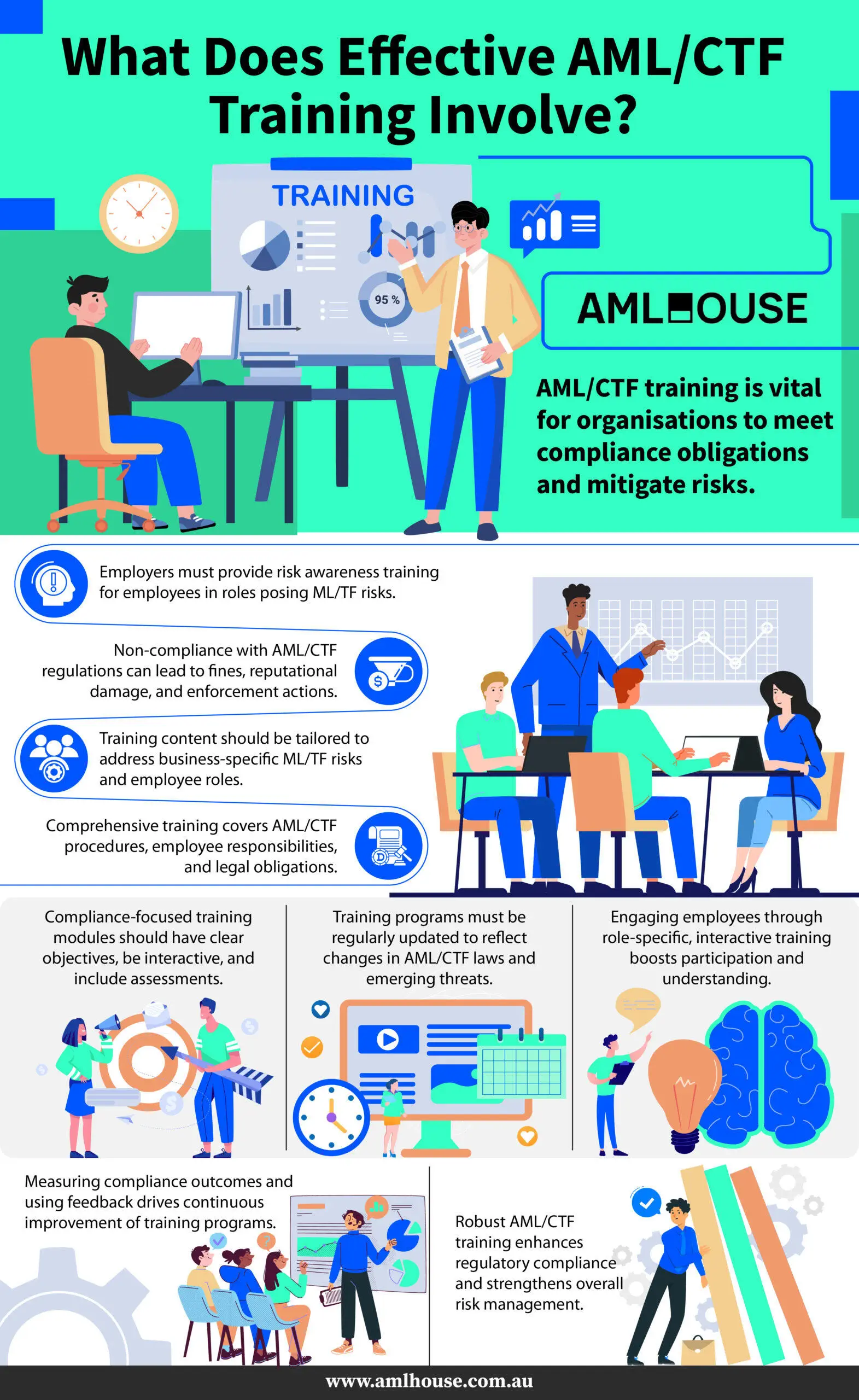Introduction
Ensuring effective Anti-Money Laundering and Counter-Terrorism Financing (AML/CTF) training is vital for organisations to meet their compliance obligations under the Anti-Money Laundering and Counter-Terrorism Financing Act 2006 (Cth) and Rules. Proper training helps mitigate and manage the risks associated with money laundering and terrorism financing, thereby safeguarding the organisation’s integrity and adherence to regulatory frameworks.
A comprehensive AML/CTF training program educates employees about their specific roles and responsibilities in identifying and reporting suspicious activities, aligning with the guidelines provided by the Australian Transaction Reports and Analysis Centre (AUSTRAC). By fostering a knowledgeable workforce, organisations can enhance their overall risk management strategies and ensure continuous compliance with evolving legal requirements.

Understanding AML/CTF Compliance Requirements
Organisations must adhere to specific compliance obligations under the Anti-Money Laundering and Counter-Terrorism Financing Act 2006 (Cth) (AML/CTF Act) and Rules to effectively mitigate money laundering and terrorism financing risks.
Legal Obligations Under AML/CTF Regulations
Under the AML/CTF Act and Rules, organisations are required to fulfil several key obligations to ensure compliance:
- Provide AML/CTF Risk Awareness Training: Employers must conduct risk awareness training for employees in roles identified as posing a money laundering or terrorism financing risk.
- Implement Processes, Systems, and Controls: Organisations must establish and maintain robust processes, systems, and controls to identify, mitigate, and manage ML/TF risks effectively.
- Regularly Review Training Programs: Training programs should be reviewed regularly to ensure they address any changes in ML/TF risks or the AML/CTF legal framework.
- Document Recommended Changes: Any changes recommended from training reviews must be thoroughly documented to maintain compliance and demonstrate ongoing improvement.
Consequences of Non-Compliance
Failing to comply with the AML/CTF Act and Rules can result in significant legal and financial repercussions for organisations:
- Legal Penalties: Non-compliance can lead to substantial fines and sanctions, reflecting the seriousness of the breach.
- Reputational Damage: Organisations may suffer reputational harm, resulting in a loss of trust among clients, stakeholders, and the public.
- Operational Impacts: Breaches can disrupt business operations, leading to increased regulatory scrutiny and potential restrictions on business activities.
- Enforcement Actions: Regulatory bodies like AUSTRAC may take enforcement actions against non-compliant organisations, including cease and desist orders or revocation of licenses.
Understanding and adhering to these compliance requirements is crucial for organisations to avoid these serious consequences and ensure their AML/CTF programs remain effective and robust.
Key Components of Effective AML/CTF Training
Effective AML/CTF training programs are crucial for organisations to comply with regulatory requirements and mitigate risks related to money laundering and terrorism financing.
Tailored Training Content
Tailoring AML/CTF training content to address business-specific ML/TF risks is essential for its effectiveness. Organisations must assess the unique risks their business faces and customise training accordingly. This customisation ensures that employees are aware of the specific threats related to their roles and the designated services they provide.
Key aspects of tailored training include:
- Role-Specific Training: Employees in different roles may encounter varying levels of ML/TF risks. For instance, those handling customer due diligence should receive more detailed training on identifying suspicious activities.
- Industry-Specific Risks: Different industries face distinct ML/TF challenges. Financial services, for example, require comprehensive training on financial crimes and the use of financial intelligence to disrupt money laundering activities.
- Regular Updates: Training programs should be regularly reviewed and updated to reflect changes in ML/TF risks and regulatory requirements. This ensures that the content remains current and relevant, helping employees stay informed about the latest threats and compliance obligations.
Comprehensive Coverage of AML/CTF Procedures
A thorough AML/CTF training program must cover the organisation’s specific procedures and the responsibilities of each employee in maintaining compliance. This comprehensive coverage ensures that all aspects of the AML/CTF framework are understood and effectively implemented.
Essential elements of comprehensive coverage include:
- AML/CTF Processes and Procedures: Employees should be well-versed in the organisation’s AML/CTF processes, including customer identification, monitoring transactions, and reporting suspicious activities. Understanding these procedures helps in the consistent application of compliance measures.
- Employee Responsibilities: Clearly defining the roles and responsibilities of each employee in the AML/CTF program fosters accountability and ensures that everyone knows their part in mitigating and managing ML/TF risks.
- Legal and Regulatory Obligations: Training should cover the organisation’s obligations under the AML/CTF Act and Rules, including the consequences of non-compliance. This knowledge reinforces the importance of adhering to legal requirements and the potential repercussions of breaches.
Incorporating these components into AML/CTF training programs helps organisations comply with regulatory standards and builds a resilient framework to prevent and detect financial crimes effectively.
Designing Training Guides for AML/CTF
Designing effective AML/CTF training modules requires a structured approach that ensures compliance and engages employees. By focusing on compliance and incorporating the latest regulatory updates, organisations can create training programs that are both informative and impactful.
Structuring Compliance-Focused Modules
Organising training sessions into compliance-focused modules helps ensure that employees understand their obligations and the importance of adhering to AML/CTF regulations. Key guidelines for structuring these modules include:
• Clear Objectives: Each module should have specific learning objectives that align with the organisation’s AML/CTF obligations. This ensures that training is targeted and relevant to employees’ roles.
• Role-Specific Content: Tailor the training content to address the unique risks and responsibilities associated with different roles within the organisation. This customisation enhances the relevance and effectiveness of the training.
• Interactive Elements: Incorporate interactive elements such as quizzes, case studies, and scenario-based exercises. These activities engage employees and reinforce their understanding of AML/CTF procedures.
• Comprehensive Coverage: Ensure that each module covers all necessary aspects of AML/CTF compliance, including identification of suspicious activities, reporting requirements, and the consequences of non-compliance.
• Regular Assessments: Include assessments at the end of each module to evaluate employees’ comprehension and retention of the material. This helps identify areas where additional training may be needed.
Incorporating Regulatory Updates
Keeping training modules up-to-date with the latest regulatory changes is crucial for maintaining compliance and addressing emerging threats. To effectively incorporate regulatory updates, consider the following strategies:
- Continuous Review: Regularly review and update training content to reflect changes in AML/CTF laws, regulations, and industry best practices. This ensures that employees are aware of the most current compliance requirements.
- Integration of AUSTRAC Guidance: Utilise AUSTRAC’s latest guidance and resources to inform updates to training modules. This provides employees with authoritative and relevant information on AML/CTF compliance.
- Timely Updates: Implement a system for promptly updating training materials whenever new regulations or enforcement actions are introduced. This proactive approach helps mitigate risks associated with outdated information.
- Documentation: Maintain thorough documentation of all updates and changes made to the training program. This includes records of regulatory updates incorporated and the dates of these changes, ensuring traceability and accountability.
- Employee Notifications: Inform employees about significant regulatory updates through training announcements or supplemental materials. This keeps everyone informed and reinforces the importance of staying current with compliance requirements.
By structuring compliance-focused modules and regularly incorporating regulatory updates, organisations can develop robust AML/CTF training programs that effectively mitigate risks and ensure adherence to legal frameworks.
Get Your Free Initial Consultation
Request a Free Consultation with one of our experienced AML Lawyers today.
Best Practices for AML/CTF Training Programs
Regular Program Reviews
Regularly reviewing your AML/CTF training program is crucial to ensure it remains effective and compliant with evolving ML/TF risks and regulatory changes. Continuous updates help address new threats and incorporate the latest legal frameworks, maintaining the program’s relevance.
Key actions for regular program reviews include:
- Assessing ML/TF Risk Changes: Evaluate how ML/TF risks have evolved and adjust training content to address these new threats.
- Updating Legal Frameworks: Integrate recent amendments to the Anti-Money Laundering and Counter-Terrorism Financing Act 2006 (Cth) and Rules to ensure training reflects current legal requirements.
- Documenting Recommendations: Record any recommended changes identified during reviews to maintain a clear audit trail and support ongoing compliance efforts.
Implementing these review processes ensures that your training program adapts to the dynamic landscape of AML/CTF regulations and effectively mitigates associated risks.
Employee Engagement Strategies
Engaging employees effectively in AML/CTF training enhances their participation and understanding, ensuring the training’s success. Tailoring training to specific roles and risks promotes relevance and increases the likelihood of compliance.
Effective strategies to boost employee engagement include:
- Role-Specific Training: Customise training modules to address the unique ML/TF risks associated with different roles within the organisation.
- Interactive Learning Methods: Incorporate interactive elements such as case studies, quizzes, and practical scenarios to make training more engaging and applicable.
- Regular Feedback and Assessments: Provide opportunities for employees to provide feedback on training sessions and conduct assessments to gauge their understanding and retention.
- Incentivising Participation: Encourage active participation by recognising and rewarding employees who consistently demonstrate strong AML/CTF compliance practices.
By adopting these engagement strategies, organisations can foster a proactive compliance culture, ensuring that employees are not only aware of AML/CTF obligations but also committed to upholding them.
Monitoring and Evaluating Training Effectiveness
Measuring Compliance Outcomes
Assessing whether your AML/CTF training objectives are being met is crucial for ensuring compliance and mitigating risks. This involves evaluating the effectiveness of the training programs in achieving their intended goals.
Key approaches to measure compliance outcomes include:
- Performance Metrics: Establish clear metrics to gauge employee understanding and application of AML/CTF procedures. Utilise tests, quizzes, and practical assessments after training sessions to evaluate knowledge retention and practical application.
- Compliance Rates: Monitor the adherence to AML/CTF processes and procedures within the organisation. High compliance rates typically indicate effective training, whereas lower rates may highlight areas needing improvement.
- Incident Tracking: Keep a record of any AML/CTF incidents or breaches. Analysing these incidents can help determine if training effectively mitigates risks, or if further training is required.
Continuous Improvement Based on Feedback
Continuous improvement of AML/CTF training programs ensures they remain relevant and effective in addressing evolving risks. Utilising feedback and assessments is essential for this ongoing enhancement.
Key strategies for continuous improvement include:
- Employee Feedback: Collect feedback from employees regarding the training’s relevance, clarity, and applicability. Surveys, feedback forms, and discussion sessions can provide valuable insights into the training’s effectiveness and areas for enhancement.
- Regular Reviews: Conduct periodic reviews of training materials and methods to incorporate the latest AML/CTF regulations and emerging threats. This ensures that the training content stays current and continues to address the most pertinent risks.
- Documentation of Changes: Maintain comprehensive records of any recommended changes to the training program based on feedback and assessment outcomes. Documenting these changes supports ongoing compliance efforts and demonstrates a commitment to continuous improvement.
By systematically measuring compliance outcomes and implementing continuous improvements based on feedback, organisations can ensure their AML/CTF training programs remain effective and aligned with regulatory requirements.
Get Your Free Initial Consultation
Request a Free Consultation with one of our experienced AML Lawyers today.
Benefits of Robust AML/CTF Training Programs
Enhanced Regulatory Compliance
A robust AML/CTF training program ensures that employees are well-informed about their obligations under the AML/CTF Act and Rules. By consistently educating staff on compliance requirements, organisations can effectively meet regulatory standards and avoid the severe penalties associated with non-compliance.
Key benefits include:
- Understanding Legal Obligations: Employees gain a clear comprehension of the specific duties they must perform to maintain compliance, ensuring that all actions align with the regulatory framework.
- Prevention of Non-Compliance: Comprehensive training reduces the risk of inadvertent breaches, safeguarding the organisation from legal and financial repercussions.
- Consistent Application of Policies: Training fosters a uniform understanding and application of AML/CTF processes across the organisation, promoting a cohesive compliance culture.
Improved Risk Management and Mitigation
Effective AML/CTF training enhances an organisation’s ability to identify, mitigate, and manage money laundering and terrorism financing risks. By equipping employees with the knowledge and tools to recognise suspicious activities, organisations can proactively address potential threats before they escalate.
Key benefits include:
- Early Detection of Risks: Employees trained in AML/CTF protocols are better equipped to identify irregular transactions and activities, enabling timely intervention.
- Enhanced Due Diligence: Comprehensive training ensures that due diligence processes are thoroughly understood and correctly implemented, reducing the likelihood of overlooking significant risk factors.
- Strengthened Operational Controls: Training reinforces the importance of robust systems and controls, ensuring that all AML/CTF procedures are effectively integrated into daily operations.
Implementing a robust AML/CTF training program ensures regulatory compliance and significantly strengthens an organisation’s overall risk management strategy, fostering a secure and resilient operational environment.
Conclusion
Effective AML/CTF training is crucial for organisations to comply with regulatory obligations and mitigate the risks associated with money laundering and terrorism financing. By implementing a comprehensive training program, businesses ensure that their employees understand their roles, the consequences of non-compliance, and the processes required to identify and report suspicious activities.
To strengthen your organisation’s compliance framework, contact our experienced team. Our specialists provide unparalleled expertise in developing tailored AML/CTF training programs that meet regulatory standards and protect your business from financial crimes. Schedule a consultation today.
Frequently Asked Questions
All relevant employees, including board members, directors, operational staff, contractors, and consultants involved in providing designated services, require AML/CTF training.
AML/CTF training should be conducted regularly, with the frequency depending on employees’ roles and the ML/TF risks faced by the business.
Yes, AML/CTF training can be outsourced to third-party service providers, provided that the reporting entity conducts due diligence to ensure the provider’s suitability and maintains oversight.
An AML/CTF training program should include obligations under the Anti-Money Laundering and Counter-Terrorism Financing Act 2006 (Cth) and Rules, consequences of non-compliance, ML/TF risk trends, identification of suspicious activities, and relevant industry guidance.
The effectiveness of AML/CTF training can be assessed through performance metrics, compliance rates, and incident tracking to ensure training objectives are met.
Failing to provide AML/CTF training can lead to legal penalties, reputational damage, and operational disruptions.
Regulators, including AUSTRAC, recommend using industry-specific guidance and resources, such as e-learning modules and financial crime guides, to support AML/CTF training.
Changes in AML/CTF regulations necessitate regular reviews and updates of training programs to ensure they reflect the current legal framework and emerging ML/TF risks.
Management plays a crucial role in supporting and overseeing AML/CTF training initiatives, ensuring that training programs align with the organisation’s compliance obligations.










